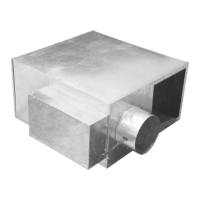34
c. With the 15 psig (or greater) thermostat signal, measure
the unit minimum airflow.
DANO
a. At a 0 psi stat signal, measure the unit minimum airflow.
b. Rotate the “LO” adjustment knob of the velocity control-
ler, adjust the minimum flow to the desired setting, as
read from the differential pressure sensor.
c. With a 15 psig (or greater) thermostat signal, measure
the unit maximum airflow.
d. Rotate the “HI” adjustment know on the velocity con-
troller, adjust the airflow to the desired maximum
setting.
11. Reconnect the power to the blower motor on the 45M,N,R
unit.
NOTE(S):
1. The single function control system uses a KMC CSC 2000
series velocity controller with a rated air consumption of
0.0083 SCFM at 20 psi main air pressure.
2. The maximum and minimum limits are both changed
when adjusting the CENTER knob. For this reason, the
center knob should always be set first.
3. Refer to the Table 30 if any of the above steps do not result
in satisfactory performance.
Table 30 — Troubleshooting Pneumatic Controls
Units with Multi-Function Controllers
(Sequences 1306-1317 and 1402-1405)
1. Determine sequence of operation (direct-acting, normally
closed [DANC], reverse-acting, normally closed [RANC],
direct-acting, normally open, or reverse-acting, normally
open). This can be accomplished by reading the diagram
affixed to the unit. All sequences above utilize a four-func
-
tion controller, allowing for changeover from a given
sequence to another.
2. Check the main air pressure at the controller. Main air
should equal 18 to 25 psi. Main air must be clean and dry.
3. Check for primary airflow in the inlet duct, using a differ-
ential pressure sensor tapped into the differential pressure
sensor signal line tees.
4. Verify that the installed room thermostat is compatible
with the unit control.
5. Close the primary air damper.
a. DANC, RANC — Disconnecting the actuator from the
controller should allow the damper to close completely.
b. DANO, RANO — Connecting a 20 psi air supply
directly to the actuator should close the damper
completely.
6. Start the blower motor by doing one of the following:
45J,K,Q Units:
DANC, RANC, DANO, RANO — Connect electrical power
to the blower motor controls.
45M,N,R Units:
DANC, DANO — Disconnect the thermostat line from the
blower control.
RANC, RANO — Connect the main air line to the blower
control, bypassing the thermostat input.
These steps should energize the fan.
7. Balance the supply outlets using a proportional air volume
method:
a. With the blower discharging full volume (SCR on maxi-
mum setting), measure the total air volume.
b. Calculate the percentage of the design air volume needed
by each outlet.
c. Multiply the total air volume by the percent-of-design air
volume for each diffuser.
d. Balance each outlet according to the requirements calcu-
lated in previous steps.
8. Balance the unit fan discharge:
a. Measure the total flow discharging from the unit.
b. Adjust the discharge flow from the unit using the unit
electronic speed control (SCR).
9. Reconnect the damper actuator to the velocity controller
with the fan still running. Make sure the piping is as
shown on the unit piping/wiring diagram.
10. Balance the primary (cooling) air volumes:
NOTE: To balance the primary air side of the 45M,N,R units
only, the blower motor must be disconnected.
a. Connect a Magnehelic or inclined manometer (0 to 2.0
in. wg scale, maximum) to the differential pressure sen
-
sor tubing.
b. Measure the volume of air flowing through the inlet
using the calibration curve affixed to the unit.
c. Adjust the “LO STAT” knob, with a 0 psi thermostat sig-
nal, to obtain the desired airflow setting. Depending on
the control sequence desired, the “LO STAT” knob will
vary either the minimum setting or the maximum setting
as follows:
DANC — “LO STAT” knob adjusts the minimum setting.
RANC — “LO STAT” knob adjusts the maximum setting.
DANO — “LO STAT” knob adjusts the minimum setting.
RANO — “LO STAT” knob adjusts the maximum setting.
Operation Sequences
1. During maximum thermostat cooling demand, the primary
air damper will open in the maximum airflow setting pro
-
viding cold primary air at the preset maximum volume.
Accessory coils, if supplied, are off, and the unit should
discharge primary air only.
2. When the thermostat modulates between maximum cool-
ing and satisfied set point, the primary air damper
responds by proportional settings. Accessory coils, if sup
-
plied, are off. The 45J,K,Q units only will be inducing ple-
num air and mixing it with the cold primary air. The
45M,N,R fan will not induce any plenum air at this point.
3. When the thermostat is modulating between maximum
heating demand and satisfied setpoint, the primary air
damper will be at the minimum air volume setting. A max
-
imum amount of plenum air is induced at this point. In
sequence, the first and second stages of electric reheat will
energize, if supplied. If hot water heating coils are sup
-
plied, they will either open fully or modulate open.
4. During thermostat demand for maximum heating, primary
air will flow through the unit at the preset minimum set
-
ting, maximum amount of plenum air will be induced, and
PROBLEM LIKELY CAUSE
Controller does not reset to
maximum minimum set point
during balancing procedure
Thermostat signal is being used for con-
trol signal. An artificial signal must be
used.
Controller does not reset to
maximum or point during
operation
Thermostat is not demanding minimum
set maximum or minimum air volume.
Main air pressure at the controller is
less than 15 psi.
Pneumatic actuator does not
stroke fully
Leak in pneumatic tubing between the
controller and the actuator. Main air
pressure at the controller is less that 15
psi. Leak in the actuator diaphragm.
Air valve stays in wide open
position
Differential pressure sensor is blocked
or obstructed. Insufficient supply air
pressure in the unit inlet.

